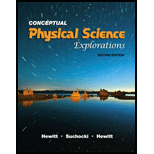
The oxygen atom of a water molecule has four pairs of electrons in its outermost shell. Do you suppose all these pairs tend to bunch together on the same side of the atom, or do these pairs tend to spread out as far apart from each other as possible. Why?
Whether the electron pairs present in outermost shell of oxygen will bunch toether or spread out.
Answer to Problem 11TE
These four electron pairs in the outermost shell of oxygen atom of water molecule Try to spread out as far as possible from each other.
Explanation of Solution
A water molecule is basically a polar covalent molecule with two hydrogen-oxygen polar bonds. The oxygen atom is a central atom making two covalent bonds with the hydrogen atoms. The oxygen atom contains six electrons in its outermost shell or a valence shell. Among those six electrons, two electrons are involved in the sharing of two electrons to form two hydrogen-oxygen covalent bonds of a water molecule and the remaining four electrons make the nonbonding pairs of electrons.
All the four bonding pairs of electrons on oxygen atom arrange themselves far apart from each other to avoid repulsions of electrons between lone pairs and bond pairs.
Conclusion:
Therefore, these four pairs of electrons in the outermost shell of oxygen atom of water molecule tend to spread out as far apart from each other as possible.
Chapter 18 Solutions
Conceptual Physical Science Explorations
Additional Science Textbook Solutions
Essential University Physics (3rd Edition)
Lecture- Tutorials for Introductory Astronomy
College Physics (10th Edition)
Conceptual Integrated Science
Applied Physics (11th Edition)
 College PhysicsPhysicsISBN:9781305952300Author:Raymond A. Serway, Chris VuillePublisher:Cengage Learning
College PhysicsPhysicsISBN:9781305952300Author:Raymond A. Serway, Chris VuillePublisher:Cengage Learning University Physics (14th Edition)PhysicsISBN:9780133969290Author:Hugh D. Young, Roger A. FreedmanPublisher:PEARSON
University Physics (14th Edition)PhysicsISBN:9780133969290Author:Hugh D. Young, Roger A. FreedmanPublisher:PEARSON Introduction To Quantum MechanicsPhysicsISBN:9781107189638Author:Griffiths, David J., Schroeter, Darrell F.Publisher:Cambridge University Press
Introduction To Quantum MechanicsPhysicsISBN:9781107189638Author:Griffiths, David J., Schroeter, Darrell F.Publisher:Cambridge University Press Physics for Scientists and EngineersPhysicsISBN:9781337553278Author:Raymond A. Serway, John W. JewettPublisher:Cengage Learning
Physics for Scientists and EngineersPhysicsISBN:9781337553278Author:Raymond A. Serway, John W. JewettPublisher:Cengage Learning Lecture- Tutorials for Introductory AstronomyPhysicsISBN:9780321820464Author:Edward E. Prather, Tim P. Slater, Jeff P. Adams, Gina BrissendenPublisher:Addison-Wesley
Lecture- Tutorials for Introductory AstronomyPhysicsISBN:9780321820464Author:Edward E. Prather, Tim P. Slater, Jeff P. Adams, Gina BrissendenPublisher:Addison-Wesley College Physics: A Strategic Approach (4th Editio...PhysicsISBN:9780134609034Author:Randall D. Knight (Professor Emeritus), Brian Jones, Stuart FieldPublisher:PEARSON
College Physics: A Strategic Approach (4th Editio...PhysicsISBN:9780134609034Author:Randall D. Knight (Professor Emeritus), Brian Jones, Stuart FieldPublisher:PEARSON





